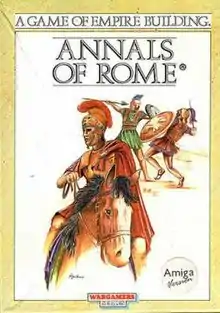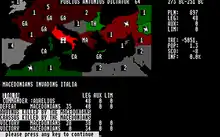Annals of Rome
Annals of Rome is a turn-based strategy video game developed and published by Personal Software Services. It was first released in the United Kingdom for the ZX Spectrum, Amstrad CPC and Atari ST in 1986. It was then released in Germany for the Commodore 64 and Amiga in 1987 and 1988, respectively. The game is set in the Late Roman Empire, with the objective being to survive for as long as possible against rebelling European states.
 Amiga cover art | |
| Developer(s) | Personal Software Services |
|---|---|
| Publisher(s) | Personal Software Services |
| Platform(s) | ZX Spectrum, Amstrad CPC, Commodore 64, Atari ST, Amiga, MS-DOS, Amstrad PCW |
| Release | 1986 |
| Genre(s) | Strategy |
| Mode(s) | Single-player |
Gameplay

The game is played in two windows. The first is the troops movement window, which allows the player to control the placement of troops in the Roman state or to attack computer players. This window shows the number of forces for all players, inflation, popularity and national score of the Roman state, and human player score. The last step for the player in this window is to set the tax rate, between 1.0 and 2.0% (higher taxes cause higher inflation). In the next window, the player decides which of the 21 Senate members will receive command of the various Roman armies. To help the player in making this decision, all Senate members are listed with numbers, the first two indicating their military ability and loyalty, respectively. The last number indicates their age. If the government's popularity falls below 2 (popularity is measured within a range between -5 and +5), armies with disloyal commanders can revolt and try to take Rome. If this happens before 50 BC, the successful rebel will be declared dictator, and if this happens after, he will become emperor, which will lead to a dynasty.
Reception
| Publication | Score |
|---|---|
| Crash | 85%[1] |
| Your Sinclair | 40%[2] |
Despite poor graphics and interface even for 1986, Annals of Rome received an 85% rating from Crash magazine in 1987.[3] In November 1986, Popular Computing Weekly called the game a "perfect choice if you take your strategy games seriously". Because of such popularity, the game received conversion to all computer platforms in its day. Originally, Personal Software Services released the game for C-64, Spectrum, Amstrad CPC and Atari ST (platforms until September 1987[3]) followed by versions for PC and Amiga. Today, the game has been considered a forgotten classic.[4]
Computer Gaming World gave the game a positive review, noting innovative mechanics such as the variable turn length. The review noted that the game felt unfinished and unpolished, citing the lack of victory conditions and poor save mechanism.[5] In 1990 the magazine gave the game three-plus out of five stars, stating that despite the poor graphics and seemingly incomplete nature, "it succeeds on many levels", especially the superior 16-bit versions.[6] In 1993 the magazine gave the game two-plus stars.[7] Orson Scott Card wrote in Compute! that Annals of Rome's programmers did an excellent job of recreating Roman history, but that sales would suffer because it "looks like it was programmed in the Bronze Age".[8]
References
- "Annals Of Rome". Crash (38). Retrieved 3 October 2016.
- "Annals Of Rome". Your Sinclair (14). February 1987. Archived from the original on 6 October 2016. Retrieved 3 October 2016.
- PSS catalogue
- Mobby about Annals of Rome
- Brooks, M. Evans (April 1989), "Annals of Rome", Computer Gaming World, no. 58, pp. 22–23
- Brooks, M. Evan (October 1990). "Computer Strategy and Wargames: Pre-20th Century". Computer Gaming World. p. 11. Archived from the original on 2 December 2013. Retrieved 16 November 2013.
- Brooks, M. Evan (June 1993). "An Annotated Listing of Pre-20th Century Wargames". Computer Gaming World. p. 136. Retrieved 7 July 2014.
- Card, Orson Scott (April 1989). "Gameplay". Compute!. p. 11. Retrieved 10 November 2013.